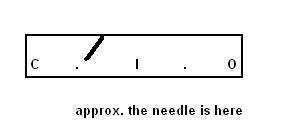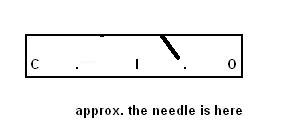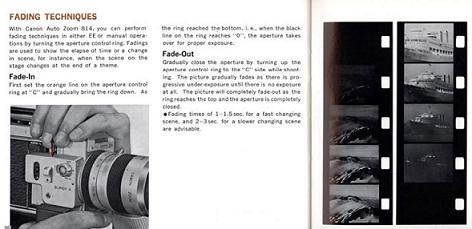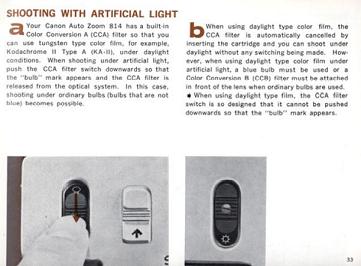|
Author
|
Topic: Canon Autozoom 814
|
|
|
|
|
|
|
|
|
|
|
|
|
|
|
|
|
|
|
|
|
|
|
|
|
Winbert Hutahaean
Film God
Posts: 5468
From: Nouméa, New Caledonia
Registered: Jun 2003
|
 posted December 18, 2009 10:07 PM
posted December 18, 2009 10:07 PM



Christian,
I am shooting Ektachrome 64T just for fun, nothing pro or serious with that. So my experience is mostly taking part in the explanation below.
If you can set the exposure manually and you will see the needle moves between close and open when you play with it, it means you are basically can shoot with this camera.
My advise is to play save by taking as many as possible outdoor scenes. When the sun is very bright and yo have a clear sky (no clouds) set the meter 1/4 between C and O.

If you are shooting during cloudy days, increase the exposure to O (open) to almost 3/4.

Never shooting in the dark (night) if you don't have a specially designed lighting for shooting (500 watt to 1000 watt). E64T will not capture anything although you fully open the exposure.
If you read the below section on your manual, you will understand the function of C and O on manual setting.

It is basically to close or to open the exposure. In other words to decrease/increase light coming into your camera.
If you are shooting in indoor (inside a house), please do only during daytime where sunlight can come into the house and set the exposure to fully open.
However if you have a proper lighting (as I mentioned above) for indoor shooting or dark scenes, you can set the exposure manually between 1/2 and 3/4.
But don't forget to release the internal filter (see the bulb sign). Otherwise you will get too warmth (red) in the tone color due to the lighting used. Read this section:

(ps: I have a feeling that your auto exposure is actually working but only the needles is broken in auto setting, just do a couple second testing in your cartridge. Set it to auto and do shooting indoor and outdoor during daytime. And see what is the result. Canon is the best camera).
[UPDATE: Accidentally I read page 13 of the manual you sent above and it reads: "BE sure that the three-way switch is set at "R". Other wise the needle meter will not move". Do you think this might be the reason for your problem?)
Have a good shooting,
--------------------
Winbert
| IP: Logged
|
|
|
|
Winbert Hutahaean
Film God
Posts: 5468
From: Nouméa, New Caledonia
Registered: Jun 2003
|
 posted December 19, 2009 10:11 PM
posted December 19, 2009 10:11 PM



quote:
where it's pretty well lit, so I don't think it will be a problem.
Well, domestic (house) lamps will not help anything to Ektachrome 64T. You have to have a special designed lighting for indoor shooting (500w to 1000 watt bulb).
quote:
I'm thinking that the battery chamber might be broken.
This is always my question why you guys talking dead batteries or battery chamber broken when working with electric camera. Practically you cannot do any shooting if you have the battery chamber broken. Simply how can the camera turn the cartridge without a power??
So can you tell me, with the batteries are inside the chamber, can you push the rec button and see if the cartridge chamber turning? If you can see it is turning, so there is no a problem with your battery chamber.
quote:
You say that I should do a few seconds of testing with auto exposure, how will I know that it works?
Since this is your first shooting with 8mm and your first experience you have to know the characteristic of your machine. Well, the only way is to sacrifice one cartridge and get processed.
OK this is not a cheap strategy since the cartridge, lab process and shipping are not cheap though. So, that is why my first advise above is to suggest you to shoot as many as possible outdoor scene during daytime. You are pretty well saved by the sunlight. After shooting your important subjet, don't forget to leave few seconds for test reel for indoor shooting, play with your "C and O" switch, etc
cheers,
--------------------
Winbert
| IP: Logged
|
|
|
|
Winbert Hutahaean
Film God
Posts: 5468
From: Nouméa, New Caledonia
Registered: Jun 2003
|
 posted December 20, 2009 08:56 AM
posted December 20, 2009 08:56 AM



quote:
Winbert, there are two seperate battery chambers:
One for the motor and zoom functions, and one for the exposure meter.
Hi Christian,
I am sorry, I didn't know thee are 2 separate battery chambers. If so, then you might be right.
Btw, as far as I remember, when I have your older brother camera (Canon 1014 XL), there was only one chamber.
quote:
In terms of shooting, won't even very bright household lights do? I'm talking about a living room with 10 crazy spotlights in the roof here
Then you have to have an external exposure meter like Claus mentiones above.
The thing with an external meter, then you have to calculate it with the sensitivity of E64T. In this regard, this issue is going to be explained by more pro-users, which I am not.
I can only talk through My experience.
Now, although you have 10 spotlights, there are several items you have to consider:
1. What is the wattage of each lamps. If it is 50w each then the total is not necessarily 500w because the 10 lights normally spread in different points.
2. How tall are lights placed. The taller is they are, the dimmer is received on surface.
3. Are they tungsten (incandescent) lights or save energy lights (neon bulb)? because save energy lights always look bright to our eyes but not to Ektachrome.
Fyi, as written on the box,Ektachrome 64T is ASA 64 for indoor use with lighy and ASA 40 for outdoor.
You have to use 200T for a successful indoor shooting with household lights. Check on youtube, there are couple test reel results for 64T and 200T indoor and outdoor shooting with Canon Camera.
cheers,
--------------------
Winbert
| IP: Logged
|
|
|
|
|
|
|
|
Winbert Hutahaean
Film God
Posts: 5468
From: Nouméa, New Caledonia
Registered: Jun 2003
|
 posted December 20, 2009 09:52 AM
posted December 20, 2009 09:52 AM



quote:
But most of the old reels I have from my grandparents are, according to my great aunt who filmed most of them, Kodachrome 40, and was shot in what she called "normal houselights".
These are all decent films, albeit a little dark.
Christian, I don't know if there is a Lab issue in this regard.
I should say that my old Kodachrome 40 from 1970s/80s look much better that the newer stock and processed in 2000.
So, this has to be answered by pro-users (and much proper answered at http://www.filmshooting.com/scripts/forum/. Many of our members here are also there. The filmshooting.com is as friendly as this forum, but they are talking about home-movies rather than packed-movies like we are here.
cheers,
--------------------
Winbert
| IP: Logged
|
|
|
|
|
|
|
|
Robert Lewis
Film Handler
Posts: 58
From: United Kingdom
Registered: Feb 2009
|
 posted December 20, 2009 05:02 PM
posted December 20, 2009 05:02 PM




Hi Christian.
I came across your posting about the difficulty you are having with the exposure meter on your Canon 814 Autozoom.
I have the model which followed yours, the 814 Autozoom E.
Both cameras have very good reputations, but there are significant differences between them. As you have said, your model requires batteries specifically for the exposure meter, and two 1.3v mercury cells are required and these must be fitted the correct way. You say you have replaced them, but the original type of cell are no longer available.
My camera does not require these because the 814 Autozoom E takes a feed from the four main batteries.
From what you say, I am not sure whether you have managed to replace the two exposure meter cells, but certainly the exposure meter will not work without them. Assuming you have replaced the cells with the modern replacements, and checked that the contacts are clean, you need to set the exposure switch to "auto" and the main power switch to "R". I believe that on your model there is a white button you can press to check whether the exposure meter cells are sufficiently powerful.
Assuming you have power for the exposure meter, try setting the meter to manual operation. Then as you turn the control wheel, you should see the "needle" in the viewfinder moving. If it does move, that indicates that the coupling to the needle itself is working. If it does not move, it suggests that the coupling has failed in some way. It may be that the auto exposure system will work even though the needle is not moving, and the only way to establish that is to try a test film.
Finally Ektachrome 64t, being a reversal stock, is exposure critical. Also, it is quite a "slow" stock and these two factors mean that you must have adequate light. Otherwise your film will be very disappointing.
I hope you will find this helpful, but if I am just taking you through what you have already done, please accept my apologies.
| IP: Logged
|
|
|



 UBBFriend: Email this page to someone!
UBBFriend: Email this page to someone!
 Printer-friendly view of this topic
Printer-friendly view of this topic






![[Confused]](confused.gif)


![[Wink]](wink.gif) The "important subject" is indoors at night you see :/
The "important subject" is indoors at night you see :/![[Smile]](smile.gif)



